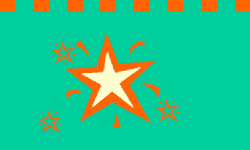A FAMILY LIKE YOURS is a strained attempt at presenting the theme “Each family is unique” as stated on the
flap of the book. The rhyming text is simple and fun to listen to, but teamed together with the illustrations, it presents
a confusing tale. The poem compares different families: “Some families dress up/ to go do the town./ And others are
happy/ just hanging around.” One problem presents itself on this page. The dressed up family is a human family, although
a silly one. The entire family seems to have gone through grandma’s attic to find “dress-up” clothes, and
the father’s top hat is huge, with a cat on top. In contrast, the family that is just “hanging around” is
a family of opossums. Lisa Gangemi Kropp, writing for School Library Journal, points out that “The use of both
humans and animals to portray different family units is distracting.” This might have been made a little less true if
the left-hand side had always been human, and the right animal, but they are sometimes flip-flopped, all human, or all animal.
Another issue is the fact that Dotlich asks the reader in the beginning, “Which one is like yours?”, but then
presents many different family situations that might fit the readers. Even families compared on the same page, such as “Some
go to the races/ and root for the cars./ Some sit on the porch/ and wish on the stars.” could both represent one child.
This could be confusing for young children who are trying to make a choice as to which family is like theirs.
Lastly, it is unclear where in time this story takes place. The text says “there are families”, not “there
have been families”, and yet we see modern dress, people in castles, renaissance-style outfits, “native country”
costumes, and even a family in a rocket ship. This lack of cohesiveness makes the entire book seem “off” in some
way, unable to make it’s point. Because of this, the end page, with the odd array of characters and the statement “But
the one that just fits/ is a family like yours” seems contrite and overly-simplistic, even for the young
readers.
The illustration style would seem just right for the age group if not for the odd choice of subjects. The simple lines
and colorful scenes are pleasant enough to look at, and drawn in a cartoon-style appropriate to the intended audience. The
final product leaves the adult reader wondering if this is what the author intended. After all, there is no reference to animals
in the text. Was this just a case of a bad author/illustrator combination? Whatever the reason, A FAMILY LIKE YOURS falls
short.
Kropp, Lisa Gangemi. 2002. Review of A Family Like Yours in School Library Journal.

